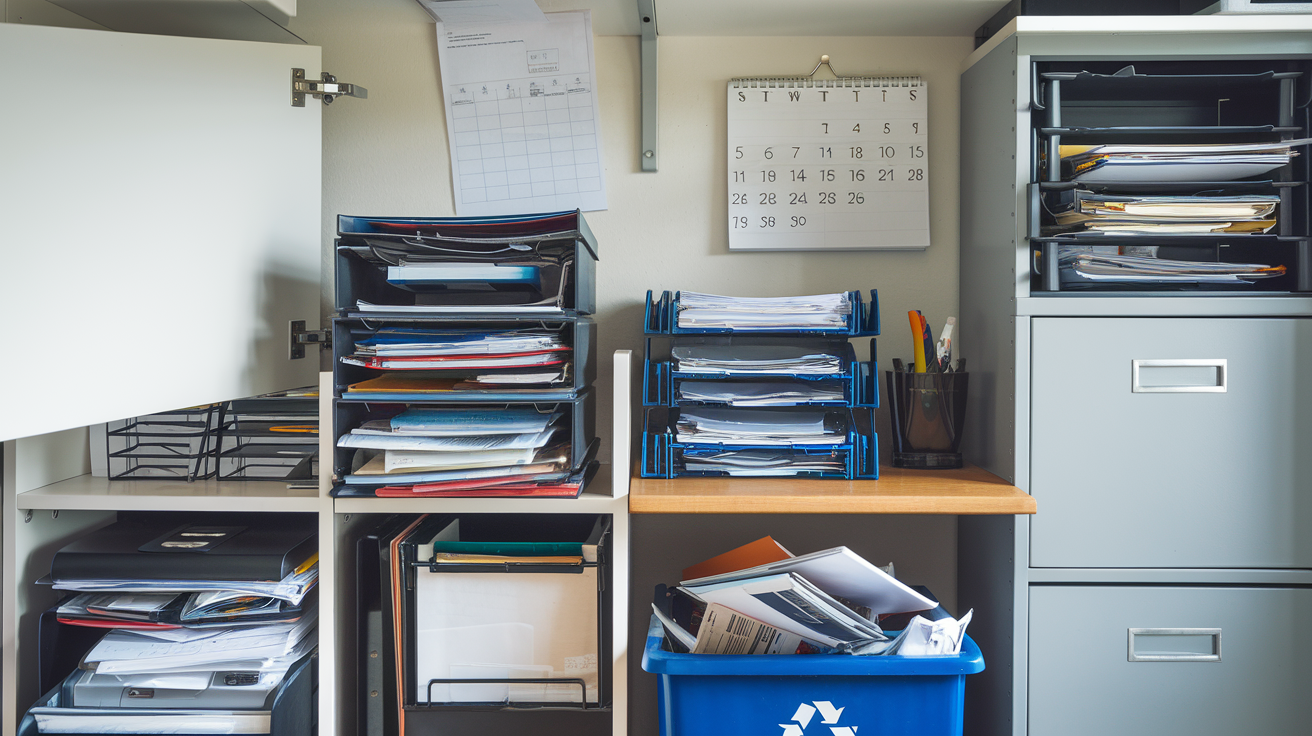
Are you drowning in a sea of paperwork as retirement approaches? 📁😓 You’re not alone. Many retirees find themselves overwhelmed by the mountain of documents accumulated over a lifetime. But fear not! Organizing your paperwork doesn’t have to be a daunting task.
Imagine the peace of mind that comes with knowing exactly where every important document is stored. Picture yourself effortlessly accessing your essential papers when needed, without the stress of frantic searching. This isn’t just a dream—it can be your reality. In this blog post, we’ll guide you through simple yet effective strategies to declutter, organize, and secure your paperwork for a peaceful retirement.
From identifying essential documents to creating an efficient filing system, we’ll cover everything you need to know to take control of your paperwork. We’ll also explore how to streamline your documents, establish maintenance routines, and ensure your important information is both secure and accessible to trusted individuals. Let’s embark on this journey to a more organized, stress-free retirement together! 🌟
Identify Essential Documents

A. Financial records
When preparing for retirement, it’s crucial to identify and organize your financial records. These documents play a vital role in ensuring a smooth transition into your golden years. Here’s a list of essential financial records to gather:
-
Tax returns and related documents
-
Bank statements
-
Investment account statements
-
Retirement account information (e.g., 401(k), IRA)
-
Pension plan details
-
Social Security statements
To stay organized, consider using the Electronic Federal Tax Payment System (EFTPS) for managing tax-related documents. This system allows you to make payments and access important tax information efficiently.
B. Legal papers
Legal documents are critical for protecting your interests and wishes during retirement. Ensure you have the following legal papers in order:
-
Will or trust
-
Power of attorney
-
Healthcare proxy
-
Living will
-
Property deeds
-
Insurance policies
It’s essential to review these documents regularly and update them as needed, especially if there are changes in your personal circumstances or state laws.
C. Medical information
Keeping your medical information organized is crucial for managing your health during retirement. Here’s a table outlining key medical documents to maintain:
| Document Type | Purpose |
|---|---|
| Health insurance cards | Proof of coverage |
| Medicare information | Benefits and coverage details |
| List of medications | Current prescriptions and dosages |
| Medical history | Record of past illnesses and treatments |
| Immunization records | Proof of vaccinations |
D. Personal identification
Personal identification documents are necessary for various aspects of retirement life. Keep these items secure and easily accessible:
-
Driver’s license or state ID
-
Passport
-
Birth certificate
-
Social Security card
-
Marriage certificate (if applicable)
-
Military service records (if applicable)
Consider obtaining an Identity Protection PIN (IP PIN) from the IRS to add an extra layer of security to your personal information.
Now that we have covered the essential documents you need to identify and organize for a peaceful retirement, we’ll explore how to create an efficient filing system to manage these important papers effectively.
Create an Efficient Filing System

Now that we’ve identified the essential documents for your retirement, it’s time to create an efficient filing system to keep everything organized. A well-structured system will save you time and reduce stress when managing your paperwork.
A. Choose between physical and digital storage
When deciding on a storage method, consider your comfort level with technology and the nature of your documents. Here’s a comparison of physical and digital storage options:
| Physical Storage | Digital Storage |
|---|---|
| Tangible documents | Electronic files |
| Requires physical space | Saves physical space |
| Easy to access without technology | Requires device and internet access |
| Vulnerable to physical damage | Protected from physical damage |
| Limited searchability | Easy to search and organize |
Many retirees opt for a hybrid approach, keeping important original documents in physical form while scanning copies for digital backup.
B. Develop a logical categorization method
Organize your documents into categories that make sense for your retirement needs. Some common categories include:
-
Financial records
-
Medical information
-
Legal documents
-
Personal identification
-
Insurance policies
-
Tax records
Consider creating subcategories within each main category for more detailed organization. For example, under “Financial records,” you might have subcategories for bank statements, investment reports, and retirement account information.
C. Implement a labeling system
A clear labeling system is crucial for quickly locating documents when needed. Here are some tips for effective labeling:
-
Use consistent naming conventions
-
Include dates on all documents
-
Color-code folders or files for easy visual identification
-
Create an index or table of contents for your filing system
For digital files, use descriptive file names and organize them into clearly labeled folders on your computer or cloud storage service.
With an efficient filing system in place, you’ll be better prepared to declutter and streamline your paperwork, which we’ll explore in the next section. By organizing your documents effectively, you’ll save time and reduce stress when managing your retirement affairs.
Declutter and Streamline

Now that we’ve established an efficient filing system, it’s time to declutter and streamline your paperwork for a more organized retirement. This process will help you maintain a tidy document collection and reduce unnecessary clutter.
A. Remove unnecessary paperwork
Identifying and removing unnecessary paperwork is crucial for maintaining an organized retirement. Start by reviewing your documents and determining which ones are no longer needed. Here’s a quick guide to help you decide what to keep and what to discard:
| Document Type | Keep | Discard |
|---|---|---|
| Tax returns | Last 7 years | Older than 7 years |
| Bank statements | Last 12 months | Older than 1 year |
| Utility bills | Last 3 months | Older than 3 months |
| Expired warranties | None | All |
| Old manuals | For items you still own | For items you no longer have |
By removing unnecessary paperwork, you’ll free up space and make it easier to locate important documents when needed.
B. Digitize important documents
Digitizing important documents is an excellent way to streamline your paperwork and ensure easy access to essential information. Consider scanning the following types of documents:
-
Legal documents (wills, power of attorney)
-
Financial records
-
Medical records
-
Insurance policies
-
Personal identification documents
Store these digital copies securely on your computer or a cloud storage service, ensuring they’re password-protected and backed up regularly.
C. Shred sensitive information
Once you’ve digitized important documents and removed unnecessary paperwork, it’s crucial to properly dispose of sensitive information to protect yourself from identity theft. Use a cross-cut shredder to destroy documents containing:
-
Social Security numbers
-
Bank account information
-
Credit card details
-
Medical records
-
Tax information
By shredding these documents, you’ll ensure that your personal information doesn’t fall into the wrong hands.
With your paperwork decluttered and streamlined, you’re now ready to establish regular maintenance routines to keep your documents organized and up-to-date.
Establish Regular Maintenance Routines

Now that we’ve streamlined and decluttered our paperwork, it’s crucial to establish regular maintenance routines to keep our retirement documents organized and up-to-date. This section will guide you through creating a system that ensures your paperwork remains in order.
Set review schedules
To maintain an organized retirement document system, it’s essential to set regular review schedules. Here’s a suggested timeline for document reviews:
| Document Type | Review Frequency |
|---|---|
| Tax-related documents | Annually |
| Retirement plan documents | Semi-annually |
| Insurance policies | Annually |
| Estate planning documents | Every 2-3 years |
By adhering to these schedules, you’ll ensure that your documents remain current and compliant with regulations.
Update information as needed
Regular updates are crucial for maintaining accurate retirement records. Here are key areas to focus on:
-
Retirement plan contributions and distributions
-
Beneficiary designations
-
Contact information for financial institutions and advisors
-
Changes in tax laws or retirement regulations
Remember, the IRS and Department of Labor may request these documents during audits, so keeping them up-to-date is vital for compliance.
Purge outdated documents
While retaining important documents is crucial, it’s equally important to remove unnecessary paperwork. Follow these guidelines for purging:
-
Keep tax returns and supporting documents for at least six years
-
Retain participant-level documentation for at least seven years post-retirement plan termination
-
Dispose of outdated notices, superseded plan documents, and expired policies
By regularly purging outdated documents, you’ll maintain a streamlined filing system that’s easier to navigate and manage.
With these regular maintenance routines in place, you’ll be well-prepared to secure your important documents, which we’ll discuss in the next section. Establishing these habits ensures that your retirement paperwork remains organized, up-to-date, and easily accessible when needed.
Secure Important Documents

Now that we’ve established regular maintenance routines, it’s crucial to focus on securing your important documents. This step is vital for protecting your valuable information and ensuring peace of mind during your retirement years.
Use fireproof and waterproof storage
When it comes to safeguarding your essential documents, investing in a fireproof and waterproof storage solution is paramount. A legacy drawer, such as a fireproof safe or a lockbox, offers excellent protection for your paper documents. This type of storage ensures that your vital records remain intact even in the face of unforeseen disasters.
| Document Type | Storage Duration |
|---|---|
| Personal records (birth certificates, marriage certificates) | Indefinitely |
| Tax documents | 7 years |
| Bank statements | Review monthly, then discard |
| Pay stubs | 1 year |
| Medical bills | At least 1 year |
Consider safe deposit boxes
For an added layer of security, consider using a safe deposit box at your bank. This option is particularly suitable for documents that you don’t need to access frequently but require maximum protection. Some items to consider storing in a safe deposit box include:
-
Original copies of wills and trusts
-
Property titles and mortgage statements
-
Insurance policies
-
Birth and marriage certificates
-
Passports (when not in use)
Implement digital security measures
While maintaining hard copies is essential, digital copies can provide convenience and additional backup. To ensure the safety of your digital documents:
-
Use secure online storage or personal computer files
-
Implement strong passwords and two-factor authentication
-
Regularly update your security software
-
Encrypt sensitive files
-
Back up your digital documents regularly
Remember to inform your loved ones about the location of both your physical and digital document storage. This leads us to our next important step: sharing information with trusted individuals, which we’ll explore in the following section.
Share Information with Trusted Individuals

Now that we’ve covered how to secure important documents, let’s focus on sharing this critical information with trusted individuals. This step is crucial for ensuring a smooth transition and peace of mind during your retirement years.
A. Inform family members about document locations
After organizing and securing your important paperwork, it’s essential to inform your family members about where these documents are stored. Create a detailed list of:
-
Document types
-
Storage locations
-
Access methods (e.g., safe combinations, digital passwords)
| Document Type | Storage Location | Access Method |
|---|---|---|
| Will | Home safe | Combination: 12-34-56 |
| Life Insurance | Filing cabinet | Top drawer, labeled folder |
| Retirement Accounts | Online portal | Username: RetireWell, Password: provided to spouse |
B. Provide access to critical information
Ensure that your trusted individuals have access to essential information related to your retirement and estate planning. This includes:
-
Contact details for financial advisors, attorneys, and accountants
-
List of all financial accounts and their respective beneficiaries
-
Information on any trusts or inherited retirement accounts
-
Details about required minimum distributions (RMDs) for retirement accounts
Remember, beneficiary designations on retirement accounts and life insurance policies typically override instructions in a will. Regularly review and update these designations to align with your current wishes.
C. Designate a power of attorney
Appointing a power of attorney is a crucial step in sharing information and ensuring your affairs can be managed if you become incapacitated. Consider the following:
-
Choose a trusted individual who understands your financial situation and wishes
-
Clearly define the scope of their authority
-
Ensure the power of attorney document is properly executed and notarized
-
Provide your designated power of attorney with access to relevant financial and legal documents
By taking these steps to share information with trusted individuals, you’re not only organizing your paperwork but also providing clarity and protection for your loved ones during your retirement years.

Organizing your paperwork is a crucial step towards a peaceful retirement. By identifying essential documents, creating an efficient filing system, and decluttering unnecessary items, you can significantly reduce stress and improve your financial clarity. Regular maintenance routines and proper security measures ensure your important documents remain up-to-date and protected.
Remember, sharing information with trusted individuals is not just about convenience; it’s about peace of mind for you and your loved ones. Take action today to streamline your paperwork and enjoy a more organized, worry-free retirement. Your future self will thank you for the time and effort invested in this important task.
